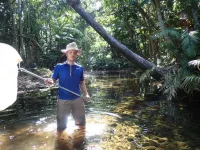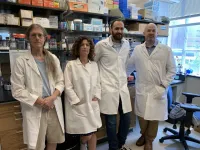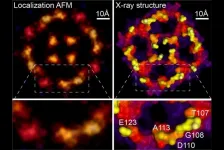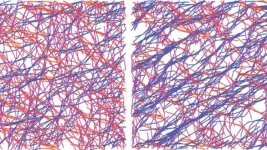Stoneflies: Youth influences adulthood
Evolutionary biologists at the University of Bonn scan 219 species in different particle accelerators
2021-06-16
(Press-News.org) In the majority of insects, metamorphosis fosters completely different looking larval and adult stages. For example, adult butterflies are completely different from their larval counterparts, termed caterpillars. This "decoupling" of life stages is thought to allow for adaptation to different environments. Researchers of the University of Bonn now falsified this text book knowledge of evolutionary theory for stoneflies. They found that the ecology of the larvae largely determines the morphology of the adults by investigating 219 earwig and stonefly species at high-resolution particle accelerators. The study has now been published in the journal Proceedings of the Royal Society B.
The stonefly species Perla marginata leads a "double life": It spends its early years as a larva in European streams. It has gills and hides under stones in flowing waters to prey on other insect larvae. "This stage is mainly spent with taking up energy and growing," says PhD student Peter Rühr from the Institute of Evolutionary Biology and Ecology at the University of Bonn. After several molts, they finally metamorphose into adult specimens that live exclusively on land. They spend most of their time on the shore and fly around in a curiously lumbering fashion to find mates. They still have mouthparts, but during their adult life, which lasts only about two weeks, they hardly consume any food. "They live mainly from the resources acquired in their larval stage," adds Rühr.
Different life stages allow morphological adaptations
What is the importance of metamorphosis in the development of stonefly species and in general? To what extent are the different life stages connected? "These questions are for instance well studied in butterflies," says evolutionary biologist Prof. Dr. Alexander Blanke of the University of Bonn. "Previous results told us that metamorphosis allows for a "decoupling" of life stages so that each stage can adapt well to different environments. In extreme cases, this might even lead to a decoupling of food uptake and reproduction phases." For stoneflies, this means that they primarily feed as a larva and reproduce only on land during the adult stage.
But, although the different life stages seem to be decoupled, this is not the case for all animal groups that undergo metamorphosis. The zoologists at the University of Bonn studied an extensive set of stonefly species and also included the closely related earwigs for comparison. "We chose these two groups because although they are closely related, they show very different ways of life," Blanke explains. Unlike stoneflies, earwigs live exclusively on land and go through many mini-stages shedding their skin several times.
Using particle accelerators at the Karlsruhe Institute of Technology, the German Electron Synchrotron in Hamburg, and the Paul Scherrer Institute in Villigen, Switzerland, the researchers scanned 219 earwig and stonefly species in order to analyze whether adult morphology is correlated with larval behaviour. The synchrotron radiation was the preferred method because it allows extremely fast scans with very high resolution. For the analysis, the researchers converted the image stacks into high-resolution three-dimensional digital models.
Comparison with almost 1000 scientific publications
The researchers then characterized the shape of the heads and compared them to data on feeding behavior and habitat use from nearly 1,000 scientific publications. They found that the change from the larval to the adult stage in stoneflies is not accompanied by a pronounced decoupling of the two stages. "The head shape of the adult stoneflies is largely influenced by the larvae," Rühr summarizes. "The ecology of the young therefore determines the appearance of the adult animals."
This refines a common thesis in evolutionary research that metamorphosis allows for a decoupling of life stages. "This is still valid for butterflies, but it is not for stoneflies," Blanke says. "A more graded view on the strength of metamorphosis would be strongly advisable." Morphological adaptations during different life stages also occur if metamorphosis is much weaker than in butterflies. Blanke: "For the first time this study sheds light on how strongly successive life stages are coupled in insects without a pupal stage."
INFORMATION:
Publication: Peter T Rühr, Thomas van de Kamp, Tomáš Faragó, Jörg U Hammel, Fabian Wilde, Elena Borisova, Carina Edel, Melina Frenzel, Tilo Baumbach and Alexander Blanke: Juvenile ecology drives adult morphology in two insect orders, Proceedings B, DOI: https://doi.org/10.1098/rspb.2021.0616
Media contact:
Peter Rühr
Institut für Evolutionsbiologie und Tierökologie
Universität Bonn
Tel. +49-228-735115
E-Mail: peter.ruehr@gmail.com
Prof. Dr. Alexander Blanke
Institut für Evolutionsbiologie und Tierökologie
Universität Bonn
Tel. +49-228-735130
E-Mail: blanke@uni-bonn.de
[Attachments] See images for this press release:

ELSE PRESS RELEASES FROM THIS DATE:
2021-06-16
Osteoporosis researchers at the UVA School of Medicine have taken a new approach to understanding how our genes determine the strength of our bones, allowing them to identify several genes not previously known to influence bone density and, ultimately, our risk of fracture.
The work offers important insights into osteoporosis, a condition that affects 10 million Americans, and it provides scientists potential new targets in their battle against the brittle-bone disease.
Importantly, the approach uses a newly created population of laboratory mice that allows researchers to identify relevant genes and overcome limitations of human studies. Identifying such genes has been very difficult but is key to using genetic discoveries to improve ...
2021-06-16
Woods Hole, MA (June 16, 2021) -- Woods Hole Oceanographic Institution (WHOI) climate modeler Dr. Alan Condron and United States Geological Survey (USGS) research geologist Dr. Jenna Hill have found evidence that massive icebergs from roughly 31,000 years ago drifted more than 5000km (> 3,000 miles) along the eastern United States coast from Northeast Canada all the way to southern Florida. These findings were published today in Nature Communications.
Using high resolution seafloor mapping, radiocarbon dating and a new iceberg model, the team analyzed about 700 iceberg scours ("plow marks" on the seafloor left behind by the bottom parts of icebergs dragging through marine sediment ) from Cape Hatteras, North Carolina to the Florida Keys. ...
2021-06-16
Researchers from the Max-Planck Institute for Terrestrial Microbiology have discovered a surprising asymmetry in the mating behavior of unicellular yeast that emerges solely from molecular differences in pheromone signaling. Their results, published in the current issue of "Science Advances", might shed new light on the evolutionary origins of sexual dimorphism in higher eukaryotes.
Resemblant of higher organisms, yeast gametes communicate during the mating process by secreting and sensing sexual pheromones. However, in contrast to higher eukaryotes, budding yeast is isogamous: seen through a microscope, gametes of both mating types ("sexes"), MATa and MATα, look exactly the same. Since anisogamy -- difference in size between male and female gametes --was ...
2021-06-16
HOUSTON ? The University of Texas MD Anderson Cancer Center's Research Highlights provides a glimpse into recently published studies in basic, translational and clinical cancer research from MD Anderson experts. Current advances include a new combination therapy for acute myeloid leukemia (AML), a greater understanding of persistent conditions after AML remission, the discovery of a universal biomarker for exosomes, the identification of a tumor suppressor gene in hepatocellular carcinoma (HCC) and characterization of a new target to treat Clostridioides difficile (C. difficile) infections.
Utilizing combination therapy for AML
While a majority of patients with acute myeloid leukemia (AML) respond favorably ...
2021-06-16
Scientists at Weill Cornell Medicine have developed a computational technique that greatly increases the resolution of atomic force microscopy, a specialized type of microscope that "feels" the atoms at a surface. The method reveals atomic-level details on proteins and other biological structures under normal physiological conditions, opening a new window on cell biology, virology and other microscopic processes.
In a study, published June 16 in Nature, the investigators describe the new technique, which is based on a strategy used to improve resolution in light microscopy.
To study proteins and other biomolecules at high resolution, investigators have long relied on two techniques: X-ray crystallography ...
2021-06-16
A new rubber band stretches, but then snaps back into its original shape and size. Stretched again, it does the same. But what if the rubber band was made of a material that remembered how it had been stretched? Just as our bones strengthen in response to impact, medical implants or prosthetics composed of such a material could adjust to environmental pressures such as those encountered in strenuous exercise.
A research team at the University of Chicago is now exploring the properties of a material found in cells which allows cells to remember and respond to environmental pressure. In a paper published on May 14, 2021 in Soft Matter, they teased ...
2021-06-16
PHILADELPHIA - Amyotrophic lateral sclerosis (ALS), also known as Lou Gehrig's disease, is a neurodegenerative disease that strikes nearly 5,000 people in the U.S. every year. About 10% of ALS cases are inherited or familial, often caused by an error in the C9orf72 gene. Compared to sporadic or non-familial ALS, C90rf72 patients are considered to have a more aggressive disease course. Evidence points to the immune system in disease progression in C90rf72 patients, but we know little of what players are involved. New research from the Jefferson Weinberg ALS Center identified an increased ...
2021-06-16
While crop yield has achieved a substantial boost from nanotechnology in recent years, alarms over the health risks posed by nanoparticles within fresh produce and grains have also increased. In particular, nanoparticles entering the soil through irrigation, fertilizers and other sources have raised concerns about whether plants absorb these minute particles enough to cause toxicity.
In a new study published online in the journal END ...
2021-06-16
Although each organism has a unique genome, a single gene sequence, each individual has many epigenomes. An epigenome consists of chemical compounds and proteins that can bind to DNA and regulate gene action, either by activating or deactivating them or producing organ- or tissue-specific proteins. As it is a highly dynamic material, it can provide a large amount of information to shed light on the evolution of the various tissues and organs that make up the body.
Now, a team from the Institute of Evolutionary Biology (IBE), a joint centre of the Spanish National Research Council (CSIC) and Pompeu Fabra University, has carried out the largest study to date on the regulatory ...
2021-06-16
By repurposing common ingredients in hair conditioner, scientists have designed an inexpensive, transparent coating that can turn surfaces like windows and ceilings into glue pads to trap airborne aerosol droplets. This new strategy is described June 16 in the journal Chem.
"Facing a pandemic, we need to proactively leverage all of the different layers of defense mechanisms, including the physical barriers," says corresponding author Jiaxing Huang, a professor of materials science and engineering at Northwestern University. "After all, these viruses must travel through physical space before reaching and eventually infecting people."
The ...
LAST 30 PRESS RELEASES:
[Press-News.org] Stoneflies: Youth influences adulthood
Evolutionary biologists at the University of Bonn scan 219 species in different particle accelerators





